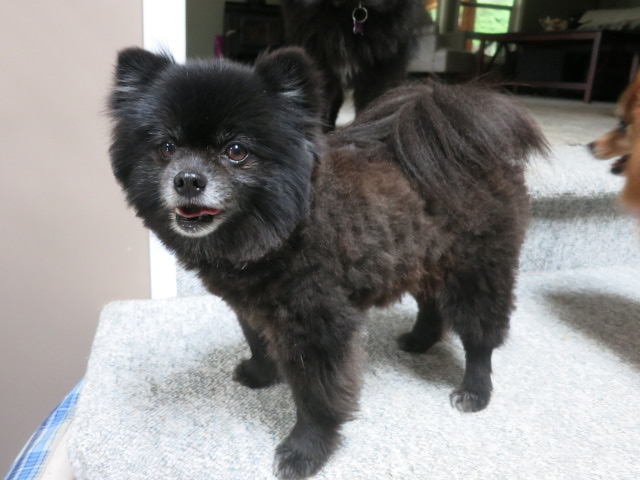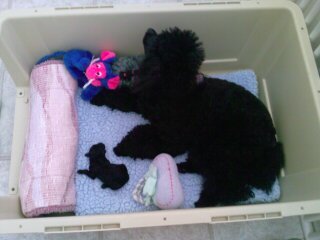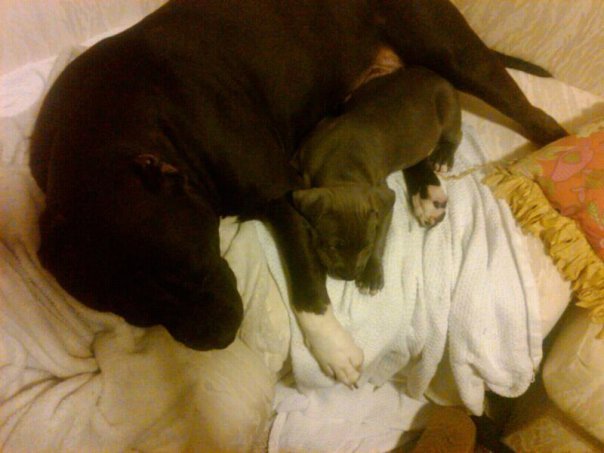QuestionQUESTION: I will have 2 older breeder female poodles that only knew a kennel. I need to know how to get them use to a leash and also how to go outside to potty. I just got the one yesterday and will get the other in a few days. They are 4 years old and the other is probably 5 years old.The one I have is very scared of going outside in the yard. I took her out several times and she did nothing but stand there. She actually held it all the day we brought her home, overnight and the next trip outside in the morning she still didn't do anything. But came back in and went potty on the carpet. She had done this twice now and I am not sure which is the best way to get her to understand that I want her to go outside.I know she has to learn the trust us and not fear her surroundings. She also is not going to the food bowl and drinking as of yet either, it is like she is afraid of the bowls. But I want to get on track with her and the new one when I get her. Thank you for any tips.
ANSWER:
Hi Donna,
Your dogs have a lot to get used to. Just having a new home is very stressful to a dog, plus they've got to get used to going outside for walks, now.
It is going to take time and plenty of patience to get your dogs used to going outside on leashes. You can't rush it. When you take your dogs outside, if they don't go to the bathroom, don't let them have the run of your house when you go back inside! You're setting your dogs up to have an accident! Instead, bring them back to the house, and either put each dog in their crate, or contain him to part of a room with a child gate or two, or use an indoor door pen. In 15 minutes, take your dog back outside for another try. Giving the dogs the unsupervised run of your home will only result in house training accidents.
Knowing your dogs are fearful, keep your walks very short until you see progress, and only then lengthen the distance you walk. It might take a couple of days or even weeks before you see progress. Coax them to walk a few steps by carrying extra special (and memorable) dog treats, such as pieces of hot dogs or cheese with you, and rewarding ANY good behavior. For the next few days of leash training, gently hold the leash as your dogs walk around your home, letting them guide you and not pulling on the leash at all. If your dog refuses to move, try pulling a little on the leash and praising them for coming with you, even just a couple of steps. Don't forget to reward them with treats! Remember it may take an adult dog longer to become accustomed to wearing a leash, and going on walks if it's never done so before.
Because your dogs are afraid to walk on a leash, you'll need to take them out on a few confidence building training sessions on a leash. Don't take him out for a walk when you're running an errand and you're in a hurry. You'll get frustrated, and the right environment in which to teach your dogs, and to overcome their fear and lack of confidence, will not be created this way.
When you're walking your dog and they suddenly stop, don't make the mistake of jerking the leash or trying to drag them along. This will just make them want to move away from you, not walking with you. The best way to deal with your dogs when they aren't cooperating on their walk is to stand still, facing away from the dogs. Put gentle pressure on the leash and wait. If your dog moves even an inch towards you, start praising her. Dogs learn best by positive reinforcement, not punishment.
Another option is to go to the end of the leash and kneel down, facing away from her. Wait for her to come to you and praise him every step of the way.
How long it takes your dog to start walking doesn't really matter, though it shouldn't take more than a minute or two. She eventually will resume walking. If she stops again, move another few feet away from her and repeat the process.
If you aren't seeing progress, then it's time to consult with a live dog trainer, rather than reading about what might be helpful. A dog trainer not only trains a dog, he or she trains you, the owner what you're doing wrong, and how to do it right. Ask your veterinarian or boarding kennel to refer you to a local dog trainer, or find one in your yellow pages under dog obedience.
Be sure to clean areas in your home where accidents have occurred with an enzymatic pet stain cleaner, such a Nature's Miracle, or Simple Solution.
Best of luck,
Patti
---------- FOLLOW-UP ----------
QUESTION: Thank you for your advice. I will try it. I am concerned that the one I have is still not going to the food/water dish. I am giving her food that she was eating at the kennel, that she ate when we handed it to her while she was sitting in her bed. Is this just something that will take a few days for her to understand it is ok? I have not given her anything by hand or layed it in front of her on the couch, I want her to go to the dish. So I even tried to put small pieces of chicken in the bowl so she would get it out and see her food, but she acts very scared when she gets near the dish, took the chicken out and moved away and ate it. How long should I let her go without eating or drinking before I should really get concerned? She is very skiddish right now. But she sits or lays on the couch with me and is calm when I pet her.
Answer
Hi Donna,
Depending on how long ago you got the dog, refusing to eat or drink is very common. If you've only had the dog for 2-3 days, it's normal. You should continue to offer the dog food frequently, and leave water out for her at all times. Again, it's a reaction to stress. An adult dog can take as from a matter of weeks to a month before it's feeling secure in a new home. Just be patient, this can't be rushed.
You might try offering her some chopped up hard boiled egg, or bits of cheese. Most dogs really love these foods, and find them hard to resist. Of course you want your dog to eat the dog food of your choice, but these treats might help jump start her into eating. If your dog seems scared by the dish, try leaving the food directly on the floor, at least at first. It sounds like this dog has an awful lot to adjust to, trying to make the transition to civilized living as gentle as possible will help her adjust faster.
This dog might do better getting acclimated to living in your home, and at least partially trained, before taking on the second rescue dog. The other rescue dog may need as much one-on-one attention and training as the dog you've just taken in.
Best of luck,
Patti

 doggie doldrums
Questionsad dog
QUESTION: I have a 2 year old go
doggie doldrums
Questionsad dog
QUESTION: I have a 2 year old go
 Will my Pomeranian loose his hair
Question
My Pomeranian`s hair c
I have a 5 year
Will my Pomeranian loose his hair
Question
My Pomeranian`s hair c
I have a 5 year
 new puppy
Question
bella
I adopted a puppy from the humane
new puppy
Question
bella
I adopted a puppy from the humane
 Diarrhea in Nursing Bitches
QuestionAtrix & Pup
QUESTION: My Champion Mi
Diarrhea in Nursing Bitches
QuestionAtrix & Pup
QUESTION: My Champion Mi
 Dog aggression towards puppy
Question
The father and his pup
My older dog is an Amer
Dog aggression towards puppy
Question
The father and his pup
My older dog is an Amer